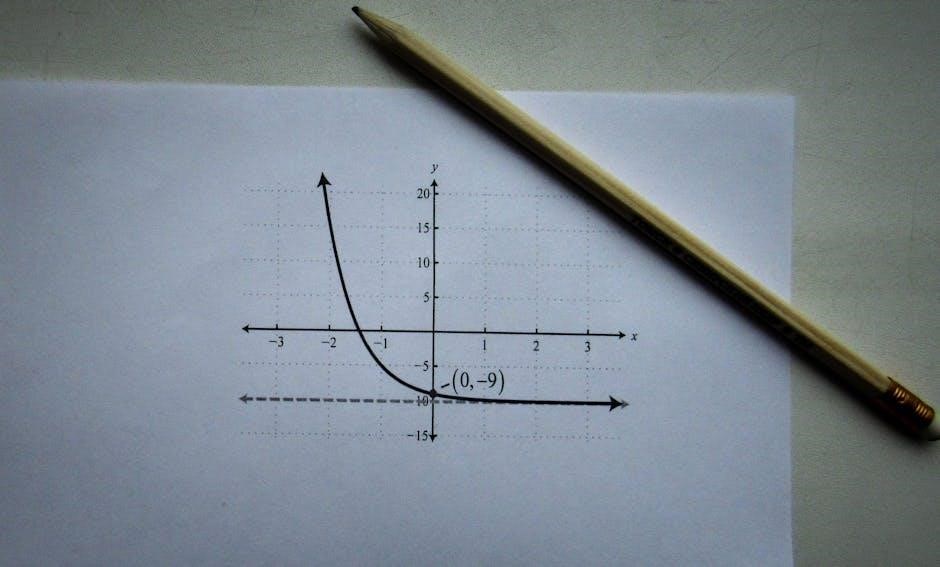Graphing inequalities involves representing solutions on a coordinate plane, showing all ordered pairs that satisfy the condition. This visual approach helps in understanding relationships between variables.
1.1 What Are Linear Inequalities?
Linear inequalities are mathematical expressions that compare two algebraic expressions using inequality signs (e.g., <, >, ≤, ≥). They can involve one or two variables and are fundamental in solving real-world problems. Unlike equations, inequalities do not have a single solution but rather a range of solutions. For example, in one-variable inequalities like 2x + 3 < 6, the solution is all real numbers x that satisfy the condition. In two-variable inequalities like y > 2x — 4, the solution is represented as a region on a graph. These inequalities are essential for modeling constraints in various fields, including economics, engineering, and science.
1.2 Importance of Graphing Inequalities
Graphing inequalities is essential for understanding solution sets as it provides a visual representation. By shading the correct region and using test points, it helps identify constraints. This method is crucial in economics, engineering, and science for modeling constraints. It also aids in solving systems of inequalities and analyzing real-world problems. This visual tool simplifies complex relationships, aiding in identification of feasible solutions.

Types of Inequalities
Inequalities can be categorized into one-variable and two-variable types. One-variable inequalities involve a single variable, while two-variable inequalities explore relationships between two variables, essential for modeling real-world scenarios.
2.1 One-Variable Inequalities
One-variable inequalities involve a single variable and are fundamental in algebra. They compare quantities, such as 3x < 6, and are solved by isolating the variable. Graphing these on a number line involves shading the appropriate side of the solution point, using open or closed circles based on whether the endpoint is included. This method provides a clear visual representation of the solution set.
2.2 Two-Variable Linear Inequalities
Two-variable linear inequalities, like 2x + 3y > 6, define regions on a coordinate plane. To graph them, rewrite the inequality as an equation to draw the boundary line. Use a solid line for inequalities with ≥ or ≤, and a dashed line for > or <. Test a point to determine which side of the line to shade, ensuring the solution region is accurately represented.
Steps to Graph Linear Inequalities in Two Variables
Graphing two-variable linear inequalities involves rewriting the inequality as an equation, determining the line type, and shading the correct region based on test points.
3.1 Rewriting the Inequality as an Equation
To graph a linear inequality in two variables, start by converting it into an equation. Replace the inequality symbol with an equal sign. For example, change 2x + y < 4 to 2x + y = 4. This equation will be graphed as a line, which serves as the boundary for the inequality's solution set. This step is crucial for identifying the region to shade.
The line type depends on the inequality symbol. If the inequality includes an equal sign (e.g., ≤ or ≥), use a solid line because the boundary is part of the solution. For strict inequalities (< or >), use a dashed line to indicate the boundary is not included. This distinction ensures clarity in identifying the solution region. After graphing the line, select a test point not on the line to determine the correct region to shade. Substitute the point into the inequality; if true, shade the region containing the point. Always choose a point that simplifies the test, ensuring accuracy. This step is crucial for identifying whether the inequality is satisfied above or below the boundary line. A test point is a point not on the boundary line used to determine the correct region to shade. Substitute the point into the inequality to check if it satisfies the condition. This step ensures the shaded area accurately represents the solution set. Selecting a test point involves picking a point that is easy to work with and not on the boundary line. Choose a point with simple coordinates, such as (0,0) or (1,1), to simplify substitution into the inequality. Avoid points on the line to ensure the test accurately reflects the inequality’s solution region. This method helps determine the correct shading direction effectively. After substituting the test point into the inequality, determine if it satisfies the condition. If the point makes the inequality true, shade the region containing the point. If it does not, shade the opposite region. This step ensures the correct area is highlighted as the solution set. Always verify the inequality symbol (≤, ≥, <, >, ≠) to apply the proper shading. Compound inequalities combine two or more inequalities, requiring the graph to show the intersection or union of their solution sets. Use shading to represent the combined regions accurately. Compound inequalities involve combining two inequalities using “and” or “or.” To graph them, first solve each inequality separately, then determine if the solution sets overlap (for “and”) or merge (for “or”); Shade the appropriate regions on the graph, ensuring the combined solution accurately represents the relationship between the inequalities. Use test points to verify the correctness of the shaded areas. To graph the solution set of compound inequalities, identify the overlapping or combined regions from the individual graphs. For “and” conditions, shade the intersection where both inequalities are true. For “or” conditions, shade all areas where either inequality holds. Ensure the final graph clearly represents the combined solution, using solid or dashed lines as needed based on the inequalities’ inclusion or exclusion of boundary lines. Absolute value inequalities represent distances from zero, often graphed as ranges on a number line or regions on a coordinate plane. They can involve one or two variables. Absolute value inequalities represent distances from a central value. To solve them, consider two cases: when the expression inside the absolute value is positive and when it is negative. For example, solving ( |x ⏤ a| < b ) involves finding values of ( x ) within ( b ) units of ( a ). Similarly, ( |x — a| > b ) involves values outside this range. Use test points to determine the correct shading direction. Graphing absolute value inequalities involves plotting the solution set on a number line or coordinate plane; For single-variable inequalities like ( |x — a| < b ), shade the interval between ( a — b ) and ( a + b ). For inequalities like ( |x — a| > b ), shade the regions outside this interval. Use open circles for strict inequalities and closed circles for non-strict inequalities. Always test points to confirm the correct region. Quadratic inequalities involve expressions with a squared variable, forming a parabola when graphed. The inequality’s direction determines whether to shade above or below the parabola. Solving quadratic inequalities involves finding the values of the variable that make the inequality true. Begin by setting the inequality to zero and solving the quadratic equation to find critical points. These points divide the number line into intervals. Test each interval to determine where the inequality holds true, ensuring the correct shading on the graph. This method ensures accurate solutions. Graphing quadratic inequalities involves sketching the parabola and determining the region where the inequality holds. Identify the direction the parabola opens (upward or downward) based on the coefficient. Plot the vertex and intercepts to sketch the curve. Shade the region above or below the parabola according to the inequality sign (> or <). Use test points to confirm the correct shading. Ensure accuracy by verifying the line type (solid or dashed). Systems of inequalities involve multiple inequalities that must be satisfied simultaneously. Graphing them requires identifying the overlapping region where all conditions are met, ensuring accurate representation. Graphing multiple inequalities involves plotting each inequality on the same coordinate plane. Start by rewriting each inequality as an equation to graph the boundary line. Use a solid line if the inequality includes equality or a dashed line if not. Shade the region that satisfies each inequality, then identify the overlapping area where all conditions are met. This intersection represents the solution set for the system. The solution region is the area where all inequalities overlap. After graphing each inequality, identify the common shaded region. This intersection represents the set of all points that satisfy every inequality simultaneously. Use test points to verify the solution region’s accuracy. The overlapping area is the feasible region where all conditions are met, providing a clear visual representation of the system’s solution. Graphing inequalities on a number line helps visualize single or compound inequalities. Use arrows to show direction and circles to indicate inclusion or exclusion of endpoints. Single inequalities involve one variable and are represented on a number line. For example, x > 3 or x ≤ 5; Use an open circle for strict inequalities and a closed circle for inclusive ones. Shade the line in the direction of the solution set, ensuring clarity in representing the values that satisfy the inequality. This method simplifies understanding and visualizing single-variable conditions effectively. Compound inequalities combine two or more inequalities, often connected by “and” or “or.” For example, x < 3 or x > 7 on a number line. Use open circles for strict inequalities and closed circles for inclusive ones. Shade separate regions for “or” conditions and overlapping regions for “and.” This method effectively visualizes complex solution sets, making them easier to interpret and analyze. Use test points to determine shading direction, distinguish solid and dashed lines clearly, and ensure accuracy in representing inequality symbols and solution regions. Common errors include misidentifying the inequality direction, using incorrect line types, and improperly shading regions. Forgetting to test points or misapplying them can lead to wrong solutions. Always check if the inequality includes equality, using a solid line, and avoid reversing inequality signs when multiplying or dividing by negatives. Carefully plotting lines and testing points ensures accuracy. Always rewrite inequalities in slope-intercept form for clarity. Use test points strategically to determine shading direction. Ensure solid lines for inclusive inequalities and dashed for exclusive ones. Double-check inequality signs after operations like multiplication by negatives. Plotting intercepts accurately helps in drawing the line correctly. Regular practice and reviewing mistakes improve graphing precision and consistency over time.3.2 Determining the Line Type (Solid or Dashed)
3.3 Shading the Correct Region
Understanding Test Points
4.1 Choosing a Test Point
4.2 Interpreting the Test Point Result
Graphing Compound Inequalities
5.1 Combining Two Inequalities
5.2 Graphing the Solution Set
Absolute Value Inequalities
6.1 Solving Absolute Value Inequalities
6.2 Graphing Absolute Value Inequalities

Quadratic Inequalities
7.1 Solving Quadratic Inequalities
7.2 Graphing Quadratic Inequalities

Systems of Inequalities
8.1 Graphing Multiple Inequalities
8.2 Finding the Solution Region
Graphing Inequalities on a Number Line
9.1 Single Inequalities
9.2 Compound Inequalities

Best Practices for Graphing Inequalities
10.1 Common Mistakes to Avoid
10.2 Tips for Accurate Graphing

Leave a Reply